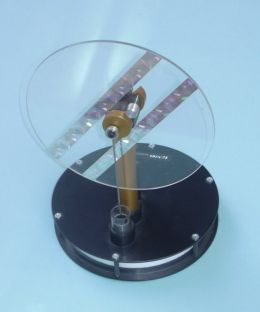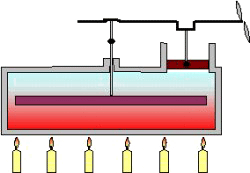
Stirling Engine
Let’s consider heating of the lower part and cooling of the upper one. Inside the engine there are two cylinders with pistons, the big piston is not tightly fitted, the air can flow around it, the work is carried out mainly by a smaller piston. The pistons rotate on the same shaft. The bigger one is ahead of the small one by 1/4 of a full thermodynamic cycle. The chamber is filled with air and tightly sealed. The picture is a schematic diagram of Stirling engine.

As a result of heating the air increases the air pressure in the chamber and forces the smaller piston up, which movement is transmitted by the transmission gear to the bigger piston, which lowers. Once, the bigger piston reaches the lowest point, a vast majority of air gets into contact with the upper cold wall. The air becomes cooler, the pressure becomes lower and the smaller piston lowers (the bigger one moves up and the whole cycle is repeated).
In short the whole thermodynamic cycle involves three processes:
1. heating,
2. decompression,
3. cooling,
4. compression.
Due to their numerous strengths such engines have found practical application as silent propulsion in some submarines. They are also used to recover heat sources and power. Sometimes they are used in liquefying air, hydrogen or helium.